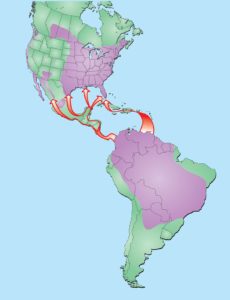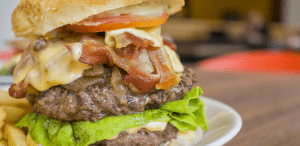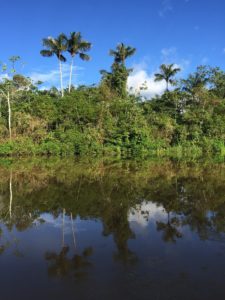We have much more to do and your continued support is needed now more than ever.
How Engaged Consumers Can Help Protect Wildlife In the Amazon
Become a Guardian of the Rainforest

There’s a reason the purple martin (Progne subis) is known as America’s backyard bird. While summering in the U.S., purple martins nest almost exclusively near towns and cities, often in man-made birdhouses. The strikingly photogenic birds certainly earn their keep because their diet of mosquitos, flies, wasps, moths, and cicadas helps to keep these insects at bay around our homes.
When winter arrives in the U.S., purple martins head south in search of warmer weather, often flying over 4,000 miles to the reach the Amazon, where they continue to feast on insects until temperatures warm in the north. But sadly, purple martins and other migratory birds that rely on the Amazon for food and habitat are seeing forests disappear as they are cut and burned to create more space for agriculture.
Purple Martin Wintering Habitat at Risk
In the Amazon, the expansion of commercial agriculture – primarily for cattle – is the leading driver of deforestation. Cattle pastures now occupy more than 118 million acres of deforested land in the Amazon, an area larger than the entire state of California.

Brazil is a global powerhouse in cattle production. The country has one of the largest cattle herds in the world (over 210 million) and is also one of the world’s largest producers and exporters of beef. The Brazilian Amazon, which accounts for over 60% of the entire Amazon rainforest, has been one of the most active regions for deforestation and the expansion of cattle ranching, with about 60 million cattle occupying the area. Although the rate of deforestation in the Brazilian Amazon has been reduced by nearly 80% since peak levels in 2004, the expansion of cattle pastures still remains the leading driver of forest loss in this region, and additional efforts are needed to effectively stop this destructive process.
This land use conversion, whereby large-scale areas of forest are cut, burned and cleared to make way for pastures used for grazing cattle, contributes to massive loss of wildlife habitat. Deforestation in the Amazon means that purple martins and other migratory species are losing habitat that is essential for their refuge and recovery during the cold winter months in the U.S.
Our Actions are More Relevant than Ever
Wildlife, deforestation, and cattle production in the Brazilian Amazon may seem like distant issues, far removed from any connection to our day-to-day decisions, but these connections are very real and the impacts that engaged consumers can make are quite significant.

Until recently, it was highly unlikely that burgers and steaks purchased in the U.S. could have originated from the Brazilian Amazon, as beef trade between the two countries was limited to only processed products, such as beef jerky and canned beef. But a recent decision by the USDA to allow imports of fresh and frozen beef products from Brazil has changed this dynamic.
Within just a few years, the U.S. could be importing up to 100,000 tons of fresh and frozen beef from Brazil each year. This means that U.S. consumers could potentially be purchasing and consuming beef products linked to the destruction of the Amazon rainforest, and therefore inadvertently contributing to the demand for products that jeopardize wildlife habitat.
What You Can Do

Although a few companies have taken steps toward addressing deforestation for the beef products that they purchase, a scorecard recently released by The Union of Concerned Scientists (UCS) indicates that meaningful action among retailers and brands is extremely limited. According to UCS’s beef scorecard, “Cattle, Cleared Forests, and Climate Change”, all 13 major companies they evaluated lacked sufficient safeguards to ensure that the beef used in their products is not linked to deforestation. These companies include large retailers like McDonalds, Burger King, and Walmart.
The good news is that companies are responsive to the concerns of their customers. With the recent USDA decision, U.S. consumers now have a greater opportunity to encourage companies to adopt commitments to zero deforestation, ensuring that the beef they use in their products does not contribute to the loss of tropical forests and the destruction of wildlife habitat.
There are several ways that you can help encourage companies to adopt and implement commitments to zero deforestation beef products.
- Ask companies simple questions like “Do you have a zero deforestation policy or commitment that covers cattle products?”
- Purchase from companies that are making progress towards verified zero deforestation production. You can refer to the Beef Scorecard for more information.
- Send a message (see examples below) to your favorite supermarket, restaurant, or brand on Facebook or Twitter and let them know that you do not want products that cause habitat destruction in the Amazon.
- @____ there’s no place for #deforestation on our menus, we need stronger commitments to #zerodeforestation beef.
- #Tropical #wildlife harmed so we can have a burger. @______ we need stronger commitments to #zerodeforestation beef.
- Is #deforestation on your menu tonight? RT @_____ to tell them we want #transparency and #zerodeforestation beef on our menus.
By actively engaging with companies where you buy products, you can help protect tropical forests and ensure that critical wildlife habitat for the purple martin and other migratory and endemic species is safeguarded.























